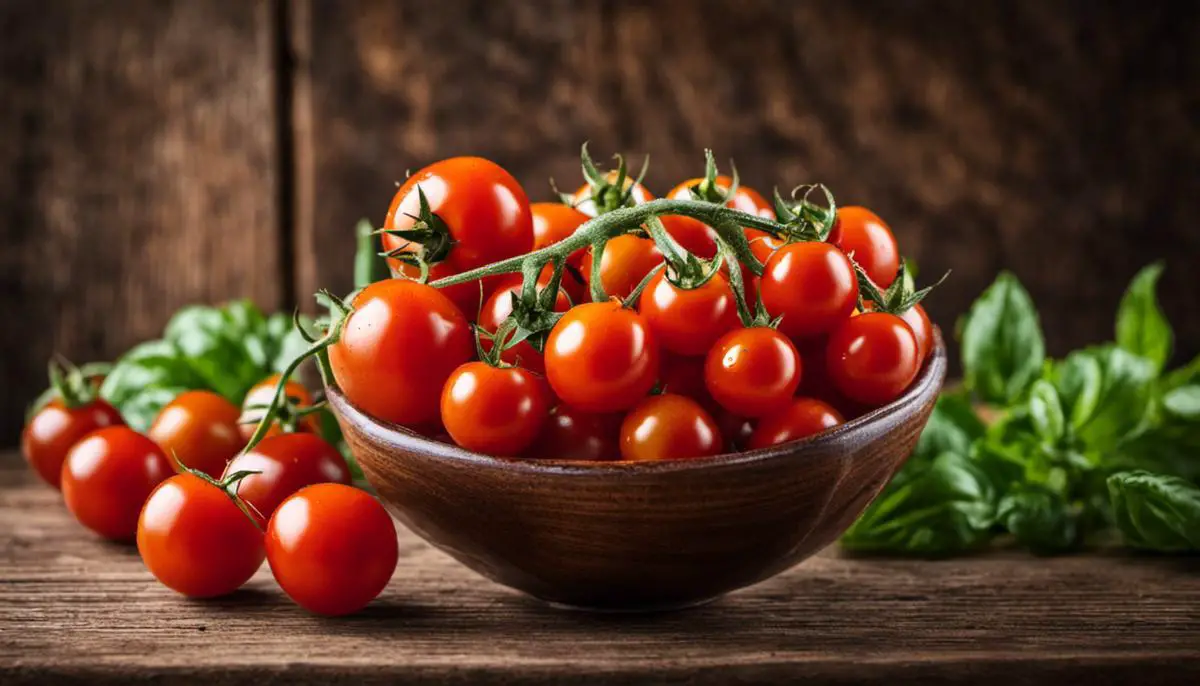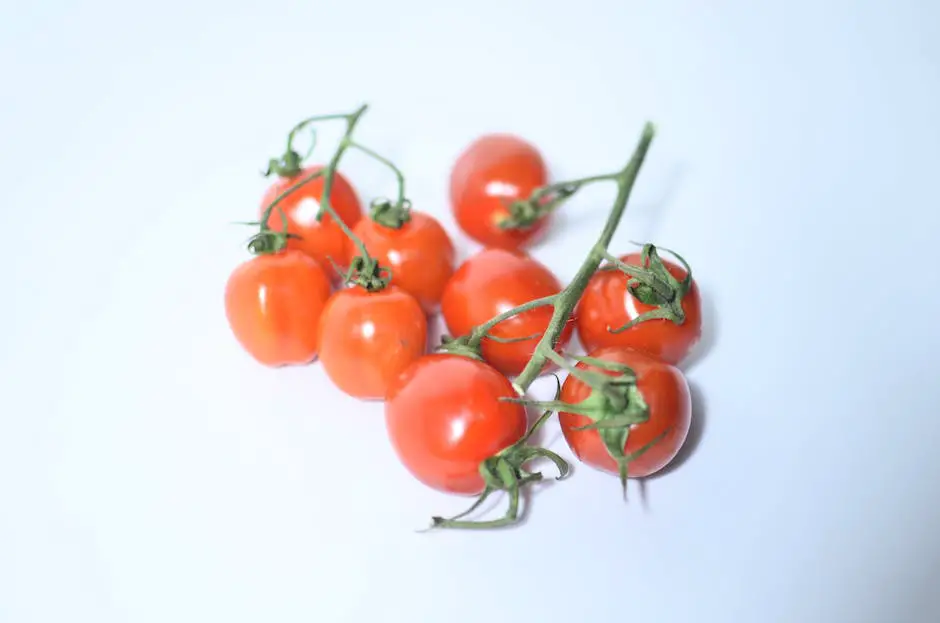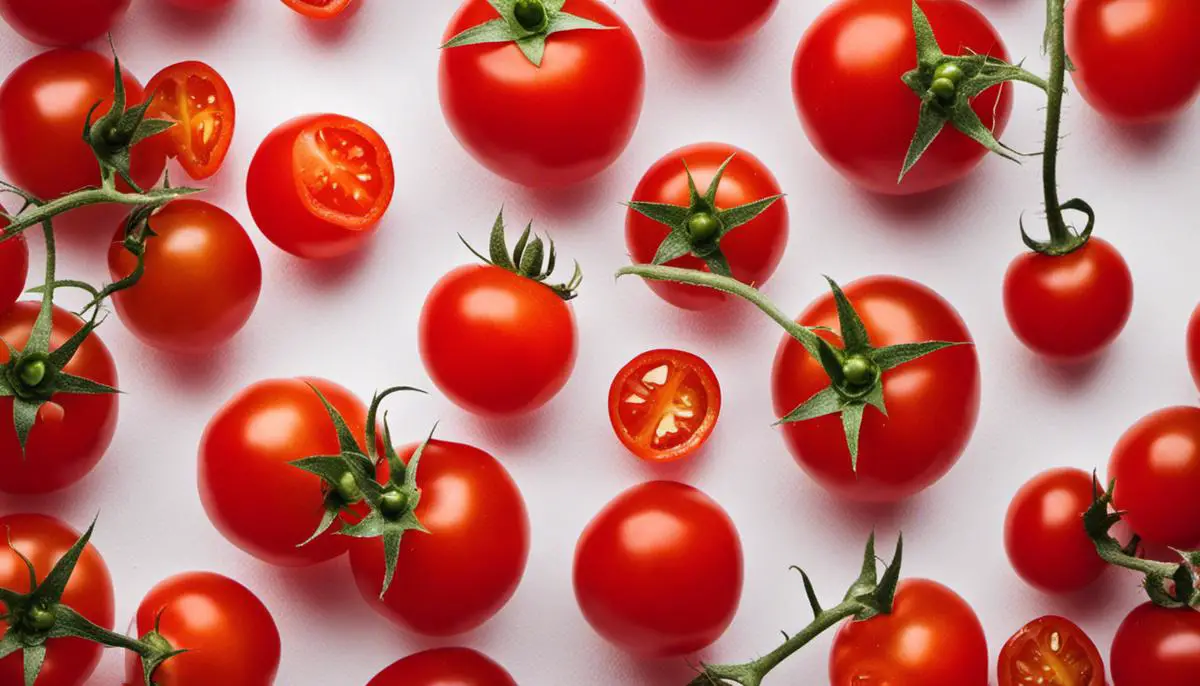Table of Contents
Cherry tomatoes, appreciated around the globe for their cheerful color and delightful flavor, have left indelible imprints on a multitude of culinary styles. Often appreciated for their convenience and versatility, their origins and cultivational history are equally fascinating. This exposition delves into the vibrant realm of cherry tomatoes, their dynamic history, how to cultivate different varieties, their nutritional significance and diverse culinary applications. Engaging in a journey, this exploration offers an in-depth understanding of the remarkable legacies and myriad facets of this ubiquitous kitchen staple.
History of Cherry Tomatoes
Origins of Cherry Tomatoes
The cherry tomato, with its appealing mini size and sweet, juicy flavor, has its roots in South America. The wild cherry tomato, classified as Solanum pimpinellifolium, is thought to originate from Peru and Northern Chile where it grew wild along the coastlines. These tiny wild fruits were much smaller than what we are accustomed to today, often no larger than a blueberry.
Early Domestication and Genetic Variants
The cherry tomato, like its larger counterparts, underwent domestication thousands of years ago, primarily in Mesoamerica where it’s known that pre-Columbian civilizations cultivated its larger cousin, the traditional tomato. Unlike modern cherry tomatoes, the wild varieties are not so perfect in shape and often irregular or elongated in form. The wild crops received lots of sunlight, which caused them to produce more sugar, contributing to their sweet taste. Over time, the process of domestication led to selection for larger and more uniform fruits. However, many of the genetic variations found in wild cherry tomatoes have been preserved in domesticated varieties, offering a vast genetic diversity for plant breeders to this day.
Introduction to the United States
The introduction of the cherry tomato in the United States took place much later. It was not until the 1900s that cherry tomatoes became a common sight in U.S. gardens. In the early 20th century, the USDA’s Bureau of Plant Industry introduced cherry tomatoes from Japan, while the Burpee Seeds Company listed them in their seed catalog for the first time in 1908.
Popularity Surge
The popularity of cherry tomatoes took off in the 1970s when many more gardeners in the United States started to grow them. Some experts attribute the rise in popularity to an increased focus on healthy eating. The small, sweet tomatoes were perfect for salads and as raw snacks. Cherry tomatoes also stood up well to the rigors of transportation and did not spoil as easily as the larger tomato varieties.
Modern Varieties
Today, cherry tomatoes come in a wide variety of types and colors, from the classic red to yellow, green, black, and even multicolored varieties. The size, shape, and taste also vary widely depending on the specific variety. Some of the most popular types of cherry tomatoes include Sweet 100, Sun Gold, and Black Cherry. Hybrid cherry tomatoes, which are the result of crossbreeding different varieties, are also commonly found in supermarkets and farmer’s markets.
Wrapping Up
In essence, the cherry tomato’s journey from the untamed coastlines of South America to becoming a staple in today’s supermarkets and home gardens reflects the undeniably adaptable nature of this scrumptious and robust fruit.

Cultivation and Varieties of Cherry Tomatoes
Nurturing Cherry Tomatoes
Given the right conditions, cherry tomatoes — a quintessential summer crop — can be grown in every USDA hardiness zone. The journey from seed to fruit begins within a greenhouse or home setting about six weeks before the last predicted frost. Crucially, a moist, well-drained soil forms the foundation for successful germination. Once at least two sets of leaves have emerged, and when frost is no longer a threat, the hardy seedlings are ready to be transplanted outdoors.
To thrive, cherry tomatoes require a minimum of six hours of direct daily sunlight. Keep in mind to plant them two feet deep while leaving around 30 inches of space between each plant. To avert diseases caused by damp foliage, such as mildew, water them in the daytime, preferably at their bases. Consistent watering is also key in preventing the fruit from splitting, a prevalent issue with cherry tomatoes.
About four weeks post-planting, sustainable growth can be promoted by applying a high-potassium fertilizer. Utilizing stakes or cages to provide support to these climbing plants is advised to prevent the fruit from coming into contact with the soil and rotting.
Periodically rotating the crop every two to three years is essential in disease prevention. Cherry tomatoes typically start to ripen around 65 days post-transplantation and are primed for harvesting when they exhibit their full color and a slightly soft exterior.
Exploring the Varieties of Cherry Tomatoes
The world of cherry tomatoes offers a range of varieties to choose from, each with its own unique set of characteristics. If you favor a sweet taste, the “Sungold” variety, known for its radiant orange fruits, might be the one for you. Similarly, the “Sweet Million” variety lives up to its name by offering a bounty of deliciously sweet red fruits.
If you prefer a richer taste, the “Black Cherry” variety, with its darker coloring, might be more to your liking. The “Supersweet 100” variety, known for its resistance to diseases and its vibrant red color, is a perfect match for salads, thanks to its delightful sweetness. Meanwhile, the “Yellow Pear” stands out with its unique pear shape, yellow color, and subtly sweet flavor.
There is a variety to suit any preference – from the pale “Italian Ice” to the ornately striped “Green Zebra” and the multi-colored “‘Rainbow Blend”. The “Cherry Punch” variety is particularly noteworthy for its exceptional disease resistance, including resistance to early blight, late blight, and tomato yellow leaf curl virus.
Differences among these varieties can be seen in their varying levels of disease resistance, patterns of growth, flavors, and colors. As such, gardeners need to take their own preferences, gardening objectives, and local conditions into account when choosing a variety. However, regardless of which variety you choose, the basic principles of cultivation are the same, setting you up for a plentiful and delicious harvest of cherry tomatoes.

Nutritional Benefits and Culinary Uses
The Nutritional Powerhouse of Cherry Tomatoes
With their vibrant colors and juicy flavors, cherry tomatoes are not only a delightful addition to your meals but also a rich source of essential nutrients. Packed with antioxidants, a single serving (one cup) of cherry tomatoes can provide around 32% of your recommended daily dose of vitamin C. This powerful antioxidant helps safeguard your body against free radicals and reduce the risk of chronic diseases.
But the nutrient content of cherry tomatoes doesn’t stop at vitamin C. They are also a valuable source of vitamin A, an essential nutrient that supports eye health, skin health, and immune function. On top of that, they offer a decent amount of potassium, a crucial mineral that helps regulate blood pressure and manage the body’s fluid balance. Not to mention, cherry tomatoes are rich in fiber, which aids digestion and helps you feel full, contributing to weight management.
Finally, cherry tomatoes are known for their high lycopene content. Lycopene is a potent antioxidant responsible for the characteristic red color of tomatoes and has been associated with a reduced risk of heart disease and certain types of cancer, particularly prostate cancer. Interestingly, cherry tomatoes contain a higher concentration of lycopene than their larger counterparts, and cooking enhances the availability of this beneficial compound.
Culinary Uses of Cherry Tomatoes
Cherry tomatoes have a versatile nature, making them a popular ingredient in various culinary preparations. Their sweet, tangy flavor adds depth and freshness to a multitude of dishes. In salads, they often serve as the juicy, vibrant counterpart to crisp greens and creamy dressings. You can simply halve them and toss them into your favorite salad mix or you can roast them for a deeper, caramelized flavor before adding to salads.
They also excel in salsas and dips, where their bright taste pairs well with spicy peppers and sweet fruits. Try them in a classic tomato salsa, or for a sweet-and-sour twist, use them in a cherry tomato and mango salsa.
Cherry tomatoes are perfectly bite-sized, making them an excellent component in kabobs, either grilled or roasted. They can be skewered with a variety of other vegetables and proteins like bell peppers, onions, mushrooms, and chunks of chicken or beef.
Cherry tomatoes are also terrific when cooked in sauces, stews, and braises. Slow-cooked cherry tomatoes become wonderfully soft and richly flavored, releasing their juices into the dish and enhancing the overall flavor. Simple pasta sauce made by simmering cherry tomatoes with garlic and olive oil is a great example.
One unique recipe that features cherry tomatoes is roasted cherry tomato tart. This recipe combines the sweetness of roasted cherry tomatoes with the creaminess of goat cheese, all nestled in a flaky pastry crust. It’s a sumptuous way to celebrate the flavor of these versatile and nutritious fruits.
Lastly, the simplest way to enjoy a cherry tomato is to eat it fresh off the vine, perhaps with a sprinkle of salt or a drizzle of olive oil. Their pop-in-your-mouth size and sweet-tart taste make them an irresistible snack.

With centuries of history, genetic variations, a richly diverse assortment of varieties, and numerous nutritional benefits, cherry tomatoes have persistently held a crucial place in the culinary world. Whether it is their integral roles in various cuisines, or their influence on health, to explore the world of cherry tomatoes is to branch into a fascinating intersection of cuisine, culture, and science. Their uniqueness extends beyond their vibrant hues and succulent taste. In essence, the humble cherry tomato epitomizes an intricate blend of past, present and future that continues to shape the landscape of our dining tables.
